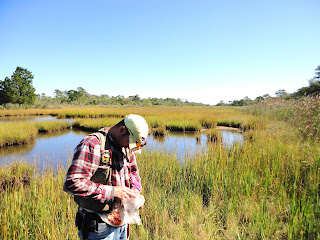Compared to Norway rats and black rats (the invasive beast and
the grungy city-dweller, respectively) The marsh rice rat is a rather handsome rodent.
But, the real reason we are here is because we want to learn about the robust, ever-versatile marsh rice rat (Oryzomys palustrus, "Marsh/Swamp Rice Mouse"). As it is semiaquatic, these mid-sized rodents flourish in marshes and the Atlantic coastal plains. Their distribution ranges from Texas through the Southeast and some parts of the Midwest, up to New Jersey.
Marsh, marsh edges, and the surrounding uplands all are likely
places to find this species. Here, my colleague J. Sparks works along
one of the trapping lines.
As their name suggests, they are bountiful in all types of marshes (saltwater and freshwater), and are able to swim great distances, sometimes holding their breath underwater for long periods of time. The longest I have counted so far is 17 seconds. On the barrier island system they have been reported to swim distances greater than 50 meters across deep channels, no easy feat for an animal that is usually smaller than a soda can. Because they are a truly hardy species, the presence of the marsh rice rat is almost the "100% guarantee" of small mammal trapping on the barrier islands we are surveying. Even on islands that are constantly shifting or are barely an island at all, a rice rat will be present. Thus, they are important players in understanding biogeography, the discipline that tries to understand how populations of species vary and function over different landscapes.
After taking measurements, this guy went on a nice underwater swim and hid in the grasses.
Another rat wanted to demonstrate its swimming abilities for the camera. Given that water
causes rapid temperature loss, it is curious to think about how these rodents survive during
colder months after being submerged. It probably has significant energy consequences.
Unfortunately, these animals are quick, and this is the only natural picture I have been
able to capture. These species are also gutsy, inhabiting grassy dunes and making sprints
across open sand.
Sources
Linzey, D.W. 1998. The Mammals of Virginia. The McDonald & Woodward Publishing Company: Blacksburg, VA.
Moncreif, N.D. and R.D. Dueser. 1994. Island Hoppers. Virginia Explorer 10(4): 14-19.
Webster, WM. D., J.F. Parnell, and W.C. Biggs, Jr. Mammals of the Carolinas, Virginia, and Maryland. The University of North Carolina Press: Chapel Hill, NC.




Look at that fella swim! Very cool captures....
ReplyDelete